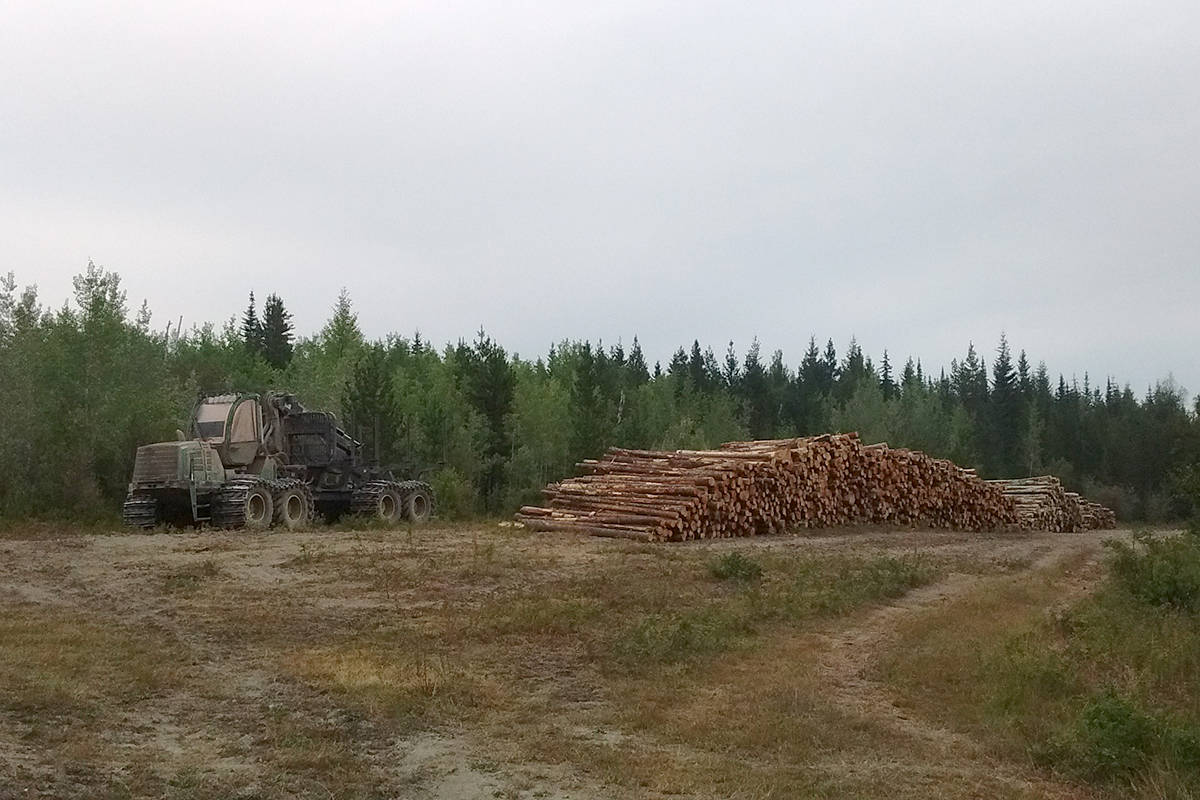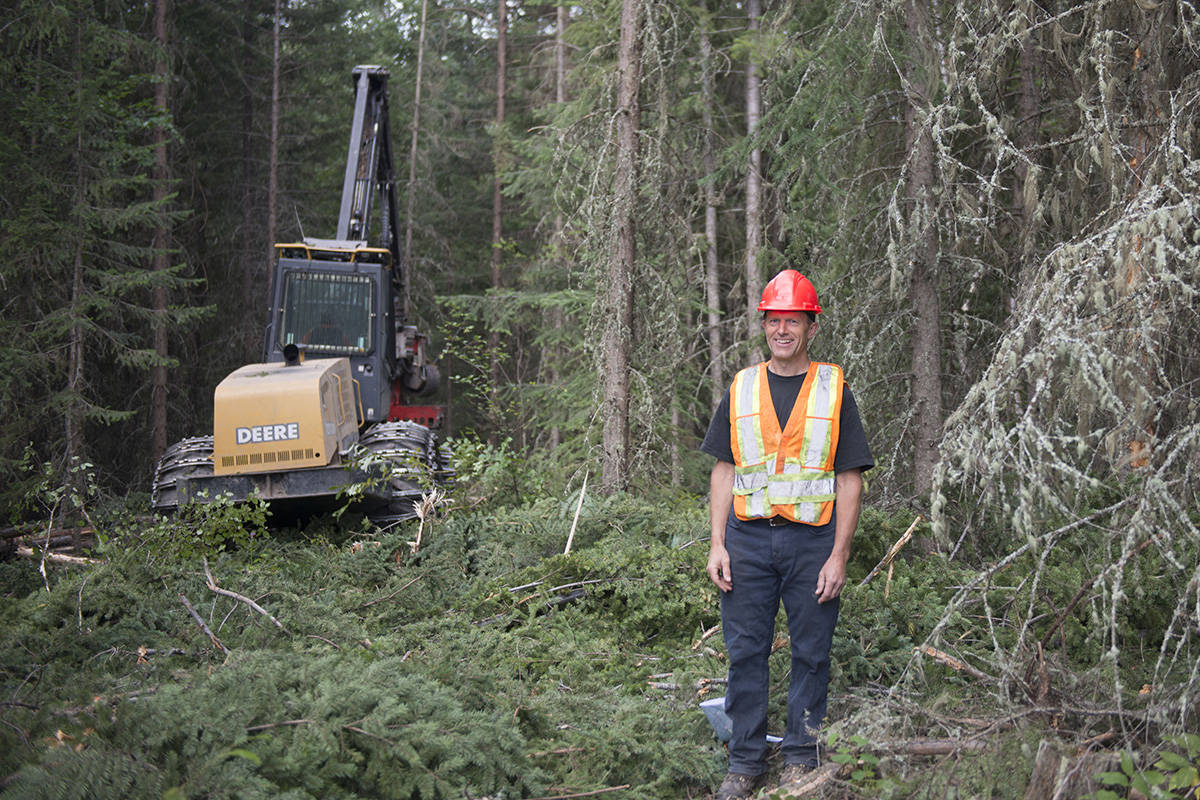The smell of fresh-cut balsam fir is a tough one to beat. Standing among recently harvested trees on a property near Quesnel, B.C., the air is thick with the aroma, along with the many mosquitos a piece of machinery has disturbed from their resting places.
Chris Elden, a local forester by trade, is logging around 50 of his 140 acre lot in the hills to the north of the city. But aside from the noise of the machinery, from the road you’d never know there was a logging operation going on in this dense patch of forest.
That’s because Elden has employed a contractor who is relatively new to the Cariboo and is using a unique system to thin out the forest without creating a great clear-cut scar in the countryside.
“This equipment is more like they use in Europe,” says Elden, who decided to log some of his property partially to manage the fuel to reduce the risk of wildfire, and partially due to the current high price of lumber.
Although the desire to log the area is based on economics, Elden didn’t want to clear cut the area.
“It’s bugged me for years. There’s a nice property and one day you drive by and all the trees are gone. You know it had the potential… they could have got the same value out of it and left some trees there.”
Elden says he’s taking just 20 to 30 per cent of the trees with this operation, and then he’ll go back every 10 or 20 years to take more.
“So it’s treed in perpetuity. It’s set up so it looks after itself.”
Elden wants people to know there are options other than clear cutting. A forester by trade, its something he has a lot of interest in and he hopes he can pass this specialty knowledge on to the general public.
“People are sitting on opportunties they probably don’t realize they can generate, and they can maybe improve the land for their own use and open up trails,” he explains.
Moores Logging, a father and son plus crew operation, is running the harvester at Elden’s Ten Mile Lake property. The machine can fell and de-limb a tree in a matter of seconds, using its felling head, which has a chainsaw to cut the tree at its base. The tree is then fed swiftly through the de-limbing knives and then placed in a pile for a forwarder to collect later. The machine has a long arm that can manouvre in and around the trees, so the operator can be fairly specific about which trees are taken.
For a smaller stand of trees, it can be more effective and more targeted than the usual feller buncher and skidder system used in commercial logging operations, which requires three pieces of equipment: one to fell the tree, one to bring the trees out to the road and one to delimb the tree before they’re loaded on a truck. The harvester does two jobs with one machine.
It’s impressive to watch. Operator Bruce Moore, the son component of the father-and-son team who run Moores Logging, says the company has been working with West Fraser Mills as well as owners of private property in the area for around a year and a half.
He’s skilled at spotting different species of trees, so is able to quickly identify which tree to choose next, knowing Elden wants to harvest the older, larger trees that are good for sawlogs, including Douglas-fir, balsam, spruce and pine, as well as some deciduous trees that can be sold for pulp production. Trees suitable for sawlogs need to have a 10-centimetre diameter at their top and a minimum length of 12 feet.
Moore is also considering the spacing of the trees, in terms of making the property less susceptible to wildfires.
“We are watching the crowns of the trees and the base of the trees to make sure they have proper spacing and to clean up the underbrush within the block. That way it prevents more fire spread. With a block that hasn’t been touched, debris underneath will catch fire and spread the fire faster. With this, if a tree gets struck by lightning there’s enough spacing that possibly it won’t spread. It’s preventative. It cleans up the forest and looks good and gets out the timber that’s worthwhile, and then we can come back in 20 years and redo it – instead of cutting the whole block down and having to replant it all,” he explains.
Smaller trees that are left behind will then have additional space and more access to sunlight, allowing them to grow larger, so they can be harvested in 20 years. In the meantime, more trees will begin to grow up in the space left behind, creating a forest that constantly regenerating itself and giving Elden economic opportunities to harvest the logs every 20 years or so.
The harvester cuts a trail around four to five metres wide, so Elden says you’ll be able to see a somewhat linear trail in the trees, but once the branches close over and the vegetation below returns, it’ll be difficult to spot where the machine did its work.
The entire operation will take around two weeks, with the harvester cutting the trees and the forwarder, run by a separate contractor, brought in afterward to bring the trees out to be transported to the mill for sale.
Elden says if locals are thinking about thinning trees on their properties, now is the time to do it, with the price of logs high.
“Someone cut down six trees on their lot in Southills and West Fraser bought it. I think it was the smallest purchase last year, like three cubic metres or something like that,” Elden says.
“[For my property] it will definitely be cash positive. The biggest cost when you are dealing with small volumes is getting the machines in. If its a thick stand of big trees, a couple of acres could be economical. If a couple neighbours got together, it might make sense,” he adds.
Elden says if people want to know more, he’s happy to take their calls and help them get in touch with local contractors. Anyone interested can contact him at 250-992-9769.
Looking back at the forest from the adjacent field – which Elden plans to turn back into forest, planting trees that, years down the road, he’ll be able to harvest sustainably – it’s almost impossible to tell where Moore has been working, aside from a tell-tale pile of logs laying near the entrance to his latest trail.
“You really don’t have to take all the trees down. People driving by won’t know anything happened,” says Elden.
READ MORE:
editor@quesnelobserver.com
Like us on and follow us on




